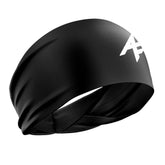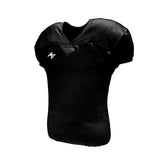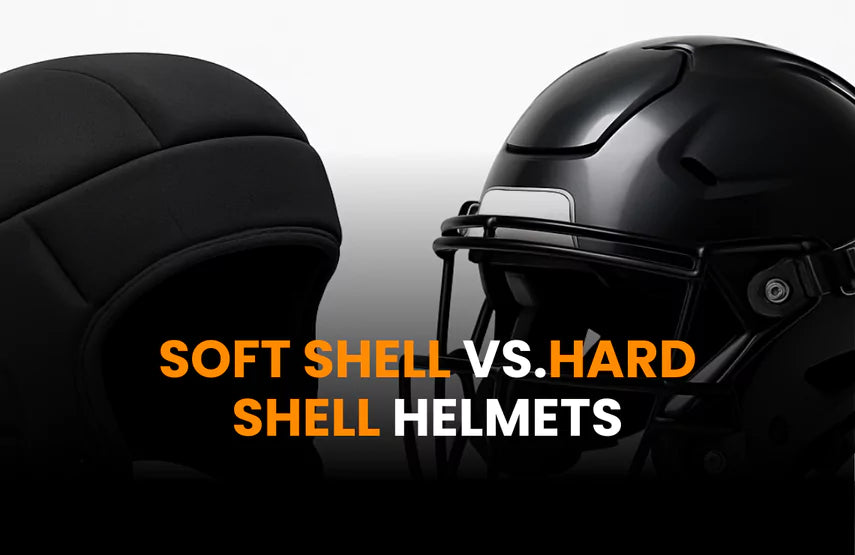Choosing the right helmet matters for safety, comfort, and confidence. If you’re comparing soft shell vs hard shell football helmet options for your program, this guide explains the real-world differences, when to use each type, and how to pick the best setup for practices, games, and 7v7.
Talk to AthleticForce1
Need gear advice for your season? Get a free consultation + quote from AthleticForce1.
The Short Answer
-
Hard-shell helmets are the classic, rigid shells used for tackle game play.
-
Soft-shell helmets are lightweight padded caps used for non-tackle, 7v7, and many practice scenarios to reduce bumps and cuts.
Rules change by state/league/age group. Always confirm what your league allows before you buy.
What is a Soft Shell Football Helmet?
Soft-shells are padded caps made from flexible foam with a fabric cover. They’re light, breathable, and easy to carry.
Why coaches like them
-
Light & cool for conditioning, walkthroughs, and 7v7
-
Adds padding during drills with incidental contact
-
Team communication is easier (players hear better)
-
Quick on/off for multi-sport athletes or split sessions
Keep in mind
-
Not a replacement for a hard-shell during tackle games
-
Check league approval for scrimmages and tournaments
-
Replace if padding compresses or cover tears
Soft shell options from AthleticForce1
Ask for team colors, sizes, and bulk pricing. Get Soft-Shell Quote
What is a Hard Shell Football Helmet?
Hard shells use a rigid outer shell with interior padding and a face mask. They’re built for the full impacts of tackle football.
Why do coaches rely on them?
-
Game-approved protection for tackle play
-
Compatible with face masks, chin straps, and visors
-
Custom fit systems (pads/air bladders) for secure retention
-
Longer service life with proper reconditioning
Keep in mind
-
Heavier and warmer than soft-shells
-
Require fit checks and periodic maintenance/reconditioning
-
More expensive upfront—but necessary for tackle
Choose other accessories like Visors and mouthguards
When To Use Which (coach scenarios)
Pre-season & conditioning
Use soft-shells for install days, speed work, and non-contact drills. Players stay cooler and you reduce incidental knocks.
7v7 & non-tackle events
Most programs choose soft-shells (check event rules). They’re lighter and let athletes move freely.
Full-contact practice & game day
Use hard-shell helmets with the correct face mask, chinstrap, and (if allowed) visor. Do fit checks before every session.
Safety Habits That Matter More Than The Model
-
Right fit: Measure head size; adjust pads/air until the helmet sits level and doesn’t shift when tugged.
-
Chinstraps: All four points secure; no slack.
-
Mouthguards: Properly fitted; players can breathe and talk.
-
Warm-up & technique: Teach heads-up tackling; no gear can replace safe form.
-
Inspections: Check screws, pads, cracks, and straps weekly; recondition hard-shells per manufacturer schedule.
Buying Checklist (simple and coach-friendly)
For soft-shells
-
Sizes for youth, women’s, men’s
-
Breathable foam and washable cover
-
Team colors/logo options
-
Bulk stock for new players mid-season
For hard-shells
-
Correct shell size + fit kit
-
Approved face mask style and chinstrap
-
Optional visor (clear/tinted per league rules)
-
Reconditioning plan (vendor + schedule)
Cost & Budgeting Tips
-
Mix the fleet: Use soft-shells for install/conditioning and hard-shells for contact, saves wear on game helmets.
-
Bundle accessories: Mouthguards, visors, and chinstraps priced together reduce per-item cost.
-
Order once: Hit bulk tiers (10/20/40+) for better pricing and keep 2–3 spares in common sizes.
Care & Lifespan
-
Soft-shell: Hand-wash or gentle cycle; air-dry flat. Replace if padding compresses or stitching fails.
-
Hard-shell: Wipe down after practice; store cool and dry; schedule reconditioning per manufacturer or program policy.
The bottom line
-
Choose soft-shell for 7v7, walkthroughs, and non-contact work.
-
Choose hard-shell for any tackle activity.
-
Teach safe technique, check fit often, and follow your league’s rules.
Get a free mockup + fast quote for helmets and accessories. Contact AF1
FAQs
Is a soft-shell helmet enough for tackle?
No. Soft-shells are for non-tackle use in most programs. Use hard-shell helmets for tackle practices and games.
Can players wear soft-shells under hard-shells?
Generally no. Follow the helmet manufacturer’s guidance. Don’t modify the fit system with extra layers.
Are tinted visors allowed?
Depends on your league and state. Clear is most widely accepted. Confirm rules before buying.
How often should we replace or recondition hard-shells?
Follow the manufacturer and your school/league policy. Inspect weekly and retire any shell with cracks or failed hardware.
Do mouthguards really affect comfort?
Yes, properly fitted guards let players breathe and talk. AF1 offers boil-and-bite and team bulk options.
Note: This guide is for general buying decisions. Always follow your governing body’s current equipment rules and the manufacturer instructions for fitting and use.




